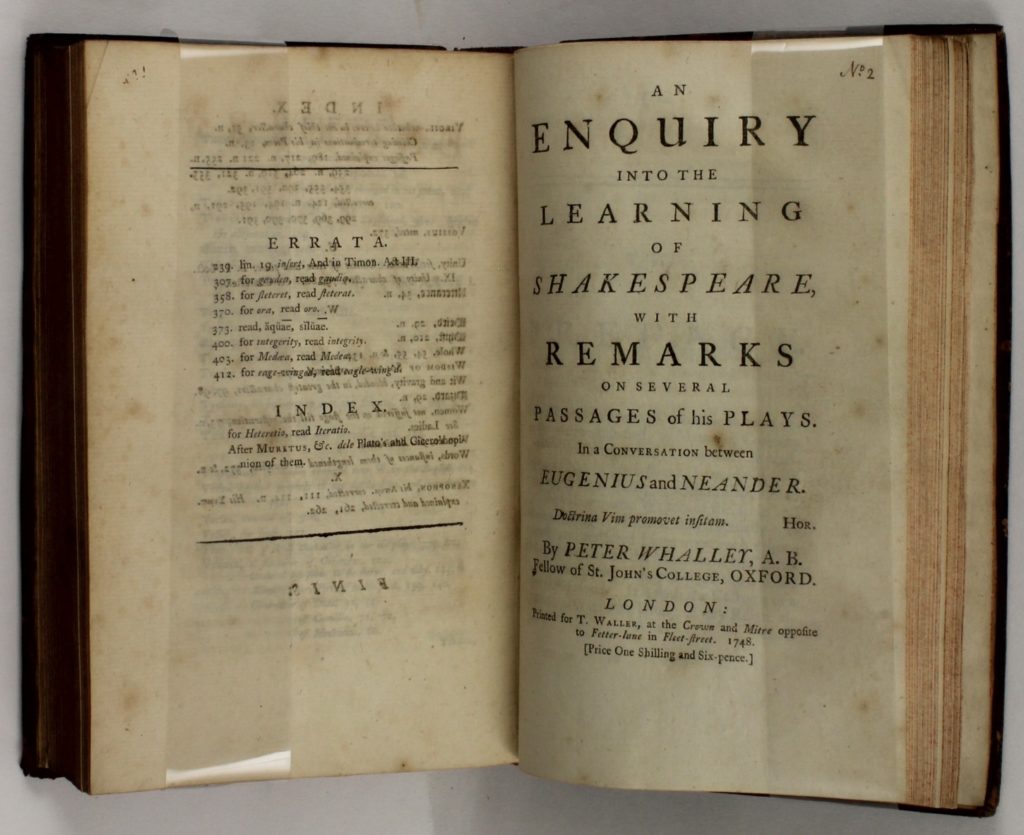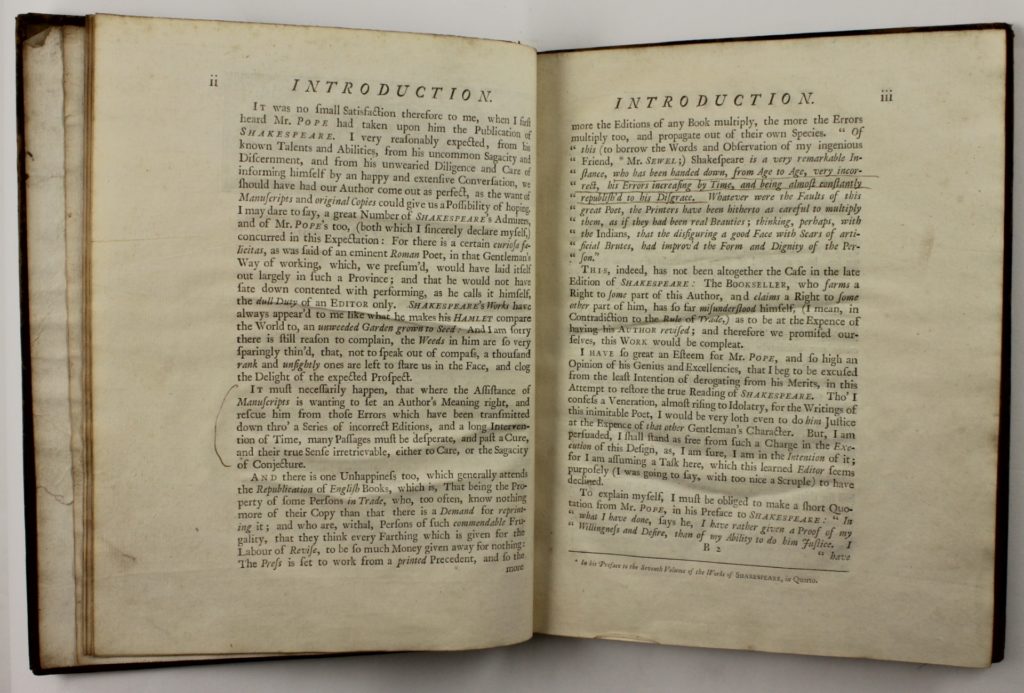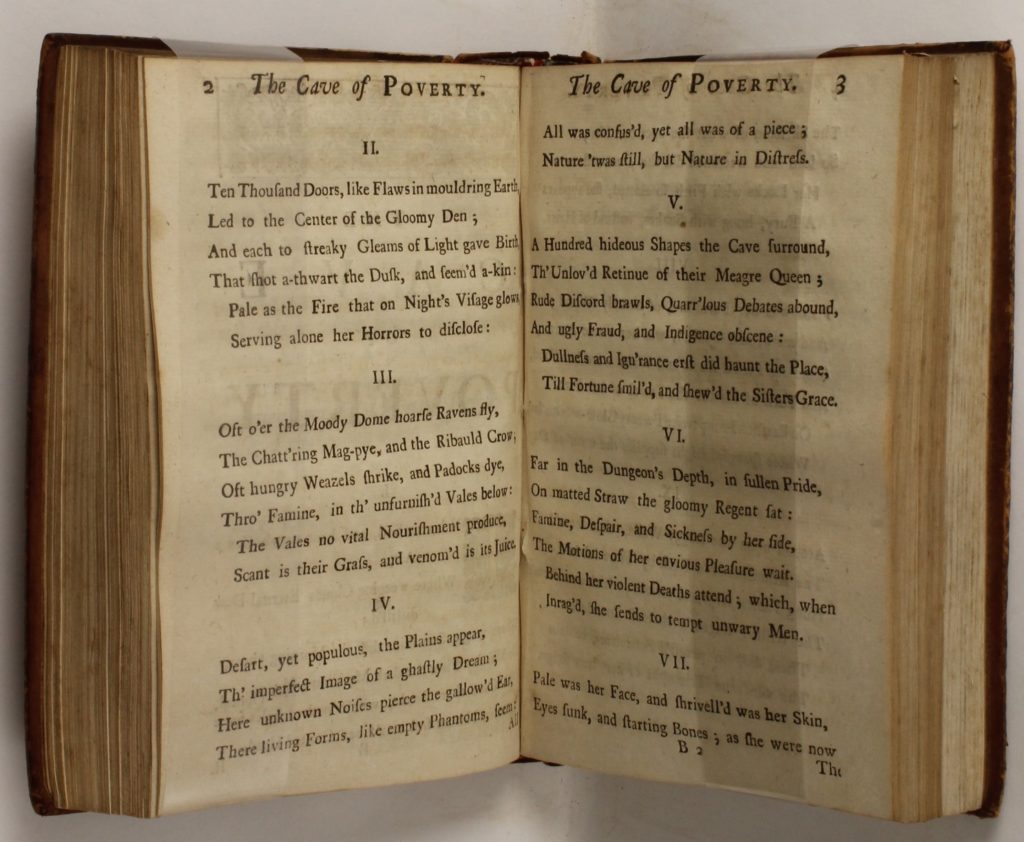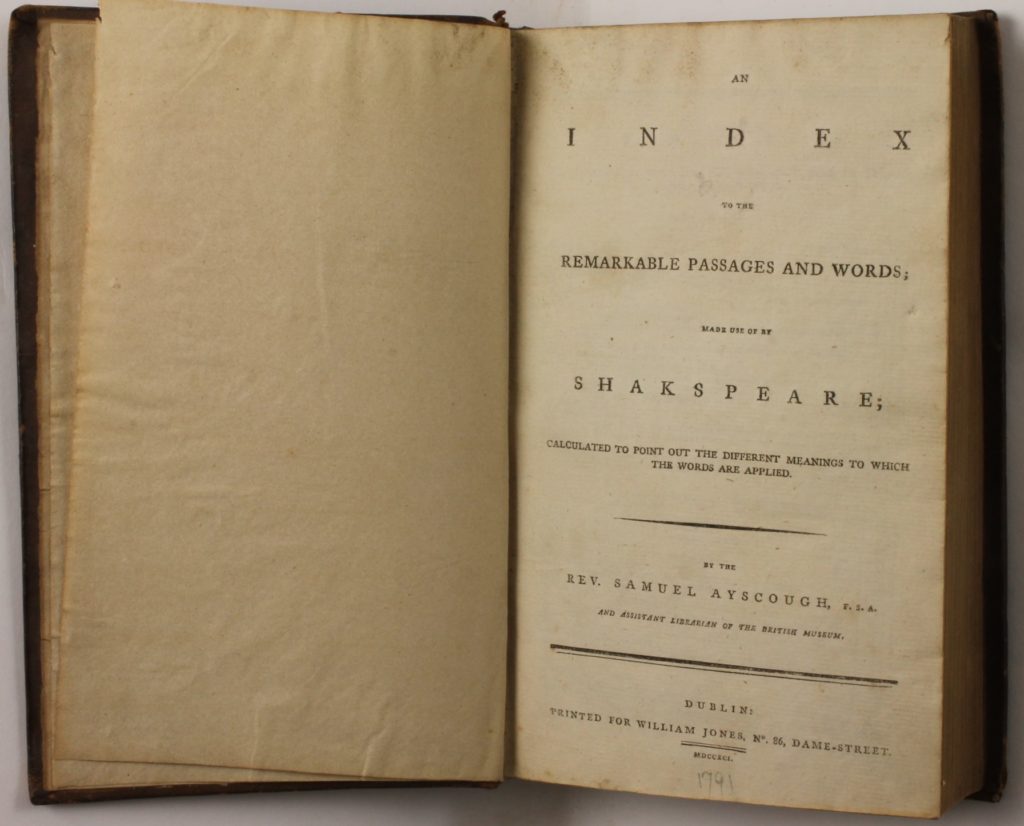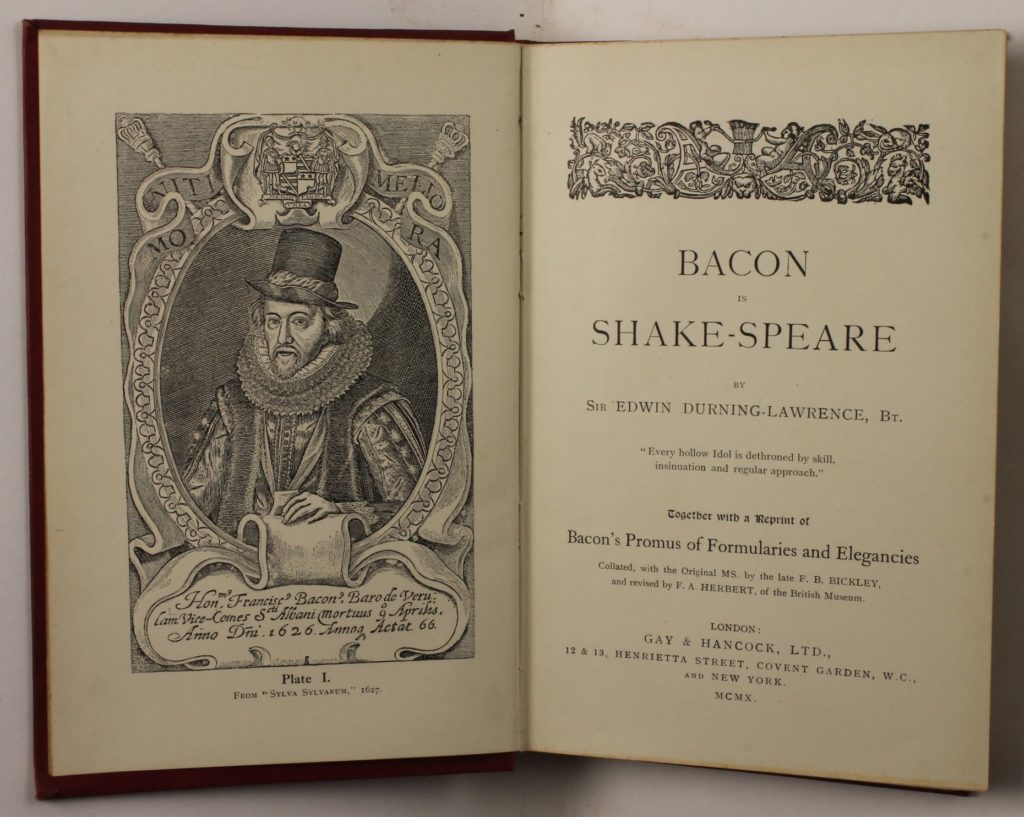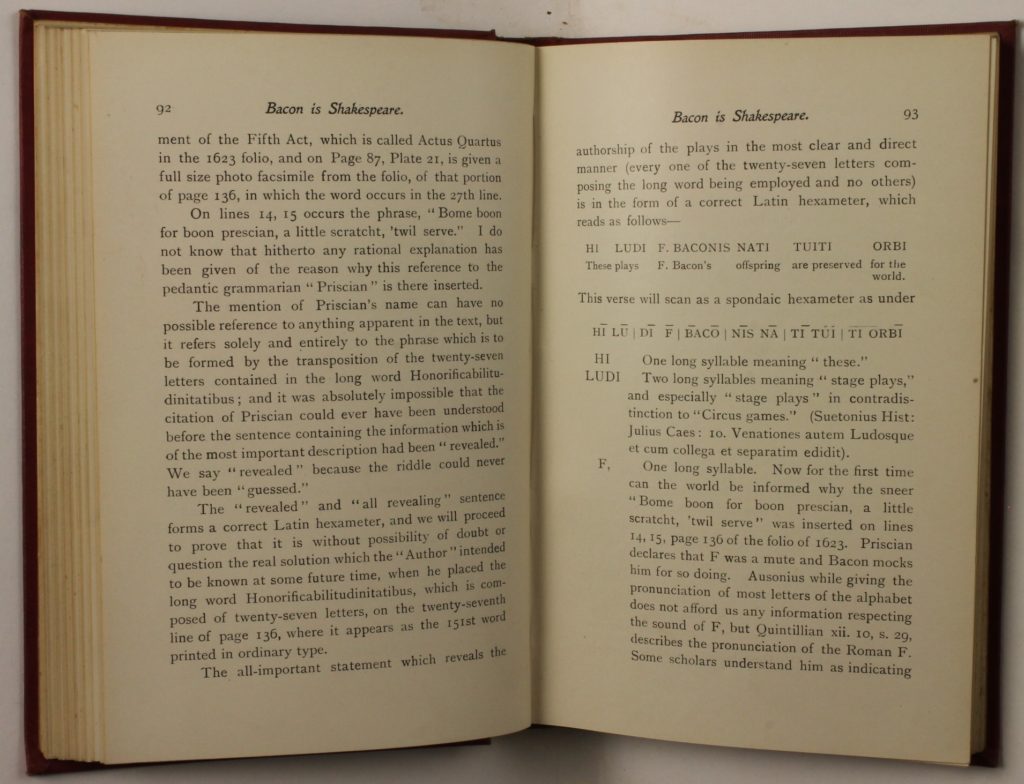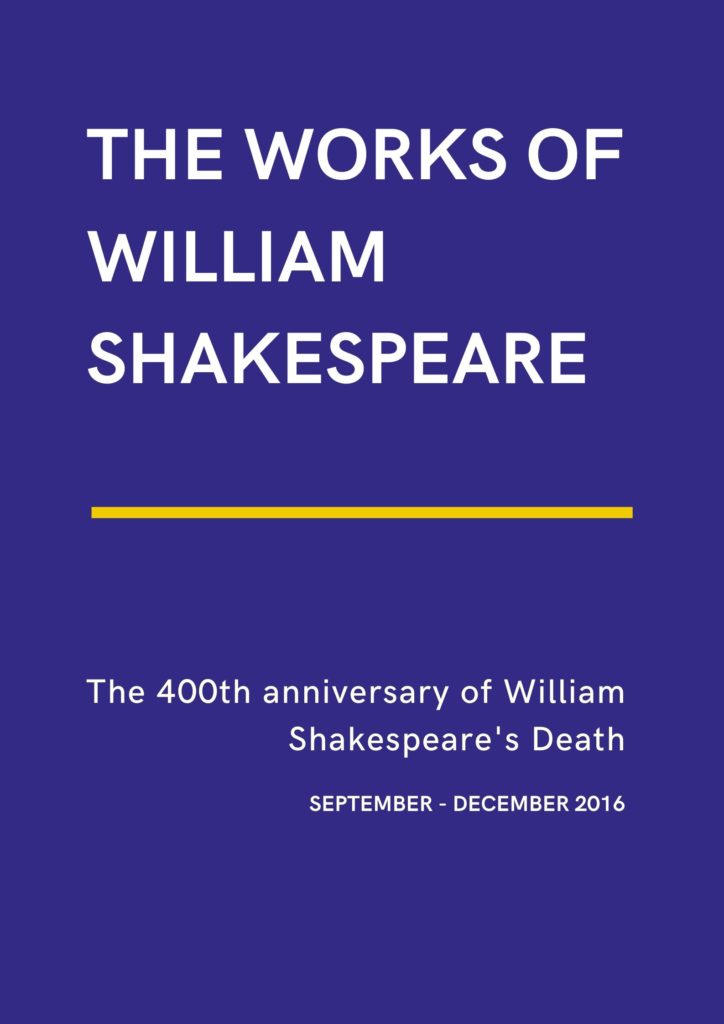
This exhibition marks the 400th anniversary of the death of William Shakespeare.
Shakespeare wrote at least 38 plays and 154 sonnets, as well as other poems. Most of his works were written between 1589 and 1613.
The Library holds copies of many works by and on Shakespeare. This exhibit shows some of the highlights.
Mr. William Shakespear’s [sic] Comedies, Histories, and Tragedies. Published according to the true Original Copies. Unto which is added, seven plays, never before printed in folio: viz. Pericles Prince of Tyre. The London Prodigal. The History of Thomas Lord Cromwel. Sir John Oldcastle Lord Cobham. The Puritan Widow. A Yorkshire Tragedy. The Tragedy of Locrine William Shakespeare 1685 P001392685
Shakespeare’s plays appeared in four folio editions in the seventeenth century, in 1623, 1632, 1664 and, as shown here, in 1685. This fourth folio contains 43 plays, including 7 which were attributed to Shakespeare, but whose authorship was later disputed.
The large volume is a prestigious work as this format of printing was reserved for important volumes of well-known authors.
This fourth folio served as the basis for eighteenth century editions of Shakespeare’s plays.
The Works of Mr William Shakespeare. Volume the Fifth. Consisting of the Tragedies : The Tragedy of Macbeth William Shakespeare 1744 P001472107
Shakespeare’s tragedy Macbeth, or ‘The Scottish Play’ is believed to have been written between 1599 and 1606.
The tragedy tells the story of the great Scottish warrior Macbeth. He receives a prophecy from three witches saying that he will become the king of Scotland.
After this he becomes consumed by ambition and kills the reigning king, taking the throne for himself.
The title page for this play depicts Act V, Scene I. Lady Macbeth is seen sleepwalking and rubbing her hands as if to rub off the blood of the people whom she and Macbeth have killed.
An Enquiry into the Learning of Shakespeare with Remarks on Several Passages of his Plays. In a Conversation between Eugenius and Neander Peter Whalley 1748 P001384364
Peter Whalley was an English clergyman, academic and writer.
In 1748 he published his Enquiry into the Learning of Shakespeare, in which he discusses Shakespeare’s classical education.
Whalley thought that Shakespeare was far more learned than many critics had previously believed.
He compares fragments written by Shakespeare with fragments from classical works, and claims that Shakespeare must have known Latin, Greek and Danish.
Whalley uses a fictitious conversation between two people to give both sides of the argument.
An Essay on the Writings and Genius of Shakespear [sic], Compared with the Greek and French Dramatic Poets. With Some Remarks Upon the Misrepresentations of Mons. de Voltaire Elizabeth Montagu 1772 P001374555
In the mid-eighteenth century the Bluestocking Society, a group of educated, intellectual women who met at literary salons, was established. The group was led by hostess and literary critic Elizabeth Montagu, cousin of Armagh Public Library’s founder Archbishop Richard Robinson.
Montagu’s Essay on Writings and Genius of Shakespeare was originally published anonymously. Her name did not appear on the text until the fourth edition in 1777.
In this work Montagu criticises the insults aimed at Shakespeare by the French writer Voltaire. Montagu considers Shakespeare to be the best dramatist of all English, Greek and French poets, and a genius.
Shakespeare Restored: Or, A Specimen of the Many Errors, As Well Committed, As Unamended, by Mr. Pope in his Late Edition of this Poet. Designed Not only to correct the said Edition, but to restore the True Reading of Shakespeare in all the Editions ever yet publish’d. Lewis Theobald 1726 P001472077
Lewis Theobald was a textual editor and author. He was a landmark figure in the editing of Shakespeare and in literary satire.
This volume is a reaction to Alexander Pope’s edition of Shakespeare and is one of Theobald’s best known works.
Theobald claimed that Pope had been both too reverent and insufficiently critical to have done Shakespeare justice, and had missed many textual errors.
Interestingly, when Pope published his second edition of Shakespeare, he adopted many of Theobald’s corrections.
The two would continue to have a sour relationship: in the satirical poem The Dunciad (1727), Pope took literary vengeance on Theobald, by using him as the son of the Goddess of Dulness, re-spelled Tibbald, crowning him ‘King of Dunces’.
The Cave of Poverty: Written in Imitation of Shakespeare Lewis Theobald 1715 P00137597
Another example of Lewis Theobald’s appreciation of Shakespeare is in his imitation of Shakespeare’s style.
This text is an extended allegory of 121 stanzas and is divided into two parts.
In the first section we are introduced to the personification of Poverty who, in a cave full of pictures of human worries, harasses mankind.
The second section describes Poverty in her cave listening to two voices, one praising wealth and the other praising poverty. This pleases Poverty as it shows the extent of her powers.
Theobald himself comments on his imitation,
[…] my imitation is very superficial; extending only to the borrowing some of his Words, without being able to follow him in the Position of them, his Style or his Elegance.
An Index to the Remarkable Passages and Words; Made Use of by Shakspeare [sic] Samuel Ayscough 1791 P002465082
Samuel Ayscough was a librarian and indexer, known as ‘The Prince of Indexers’.
In 1782 he published a catalogue of the then unidentified manuscripts in the British Museum as a private venture. In 1785 he was appointed Assistant Librarian at the Museum.
In 1791 he published an index to the works of Shakespeare to indicate what they were about, to summarise their content and to improve findability.
Indexing passages and words from the works of Shakespeare was a monumental task. The 669 page-long index is a credit to Ayscough’s skill in and dedication to indexing.
Shakespeare’s Sonnets Reconsidered, and in Part Rearranged with Introductory Chapters, Notes, and a Reprint of the Original 1609 Edition Samuel Butler 1899 P001155918
Samuel Butler was an English author and translator, known for Erewhon and The Way of All Flesh, semi-autobiographical novels.
Butler held Shakespeare in high regard and had supposedly learned all 154 of Shakespeare’s sonnets by heart.
He set out to arrange the sonnets and to give them an original order. Butler supported the theory that the sonnets were letters.
In Butler’s words,
The Sonnets are a series of unguarded letters in verse, written as the spirit moved a young poet who has just discovered his own gift […] Such letters inevitably record varying phases of the writer’s mind
Bacon Is Shake-Speare [sic] Sir Edwin Durning–Lawrence 1910 P001006726
Sir Edwin Durning-Lawrence was a British lawyer and Member of Parliament. He is best known for his support of the Baconian theory of Shakespeare’s authorship, that is, that Francis Bacon wrote the works attributed to Shakespeare.
Shakespeare’s authorship was first questioned in the nineteenth century.
It was suggested that, among others, Sir Frances Bacon, Christopher Marlowe or Edward de Vere were the true authors.
In this work, Durning-Lawrence compiles evidence in support of Sir Francis Bacon as the true author. He published a number of books on this subject and promoted public debates within the academic community.




